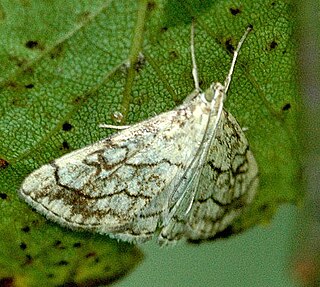
Evergestinae is a fairly small subfamily of the lepidopteran family Crambidae, the crambid snout moths. The subfamily was described by H. Marion in 1952. It contains roughly 140 species on all continents and continental islands. Evergestine moths resemble Pyraustinae; however, the male genitalia have a long uncus and long, slender gnathos. The larvae feed mostly on Brassicaceae.

Spilomelinae is a very species-rich subfamily of the lepidopteran family Crambidae, the crambid snout moths. With 4,132 described species in 340 genera worldwide, it is the most speciose group among pyraloids.

The Thyrididae comprise the family of picture-winged leaf moths. They are the only family in the superfamily Thyridoidea, which sometimes has been included in the Pyraloidea, but this isn't supported by cladistic analysis.

The Pyralinae are the typical subfamily of snout moths and occur essentially worldwide, in some cases aided by involuntary introduction by humans. They are rather rare in the Americas however, and their diversity in the Australian region is also limited. Altogether, this subfamily includes about 900 described species, but new ones continue to be discovered. Like many of their relatives in the superfamily Pyraloidea, the caterpillar larvae of many Pyralinae – and in some cases even the adults – have evolved the ability to use unusual foods for nutrition; a few of these can become harmful to humans as pests of stored goods.

Omiodes is a moth genus in the family Crambidae. Several species are endemic to Hawaii.

Ostrinia is a genus of moths in the family Crambidae described by Jacob Hübner in 1825. Several of them, including the European corn borer, are agricultural pests.

Anania is a genus of moths of the family Crambidae described by Jacob Hübner in 1823.
Mimudea is a genus of moths of the family Crambidae described by William Warren in 1892.
Prionopaltis is a genus of moths of the family Crambidae described by William Warren in 1892.

Sericoplaga is a monotypic moth genus of the family Crambidae described by William Warren in 1892. Its one species, Sericoplaga externalis, described by the same author in the same year, is found in North America, where it has been recorded from Maryland to Illinois, south to Florida and west to Texas.

Sterrhinae is a large subfamily of geometer moths with some 3,000 described species, with more than half belonging to the taxonomically difficult, very diverse genera, Idaea and Scopula. This subfamily was described by Edward Meyrick in 1892. They are the most diverse in the tropics with the number of species decreasing with increasing latitude and elevation.

Asthenini is a tribe of geometer moths under subfamily Larentiinae first described by Warren in 1893. The tribe has been combined with Eupitheciini in the past, most notably by Jeremy Daniel Holloway in his work The Moths of Borneo.

Eupitheciini is a tribe of geometer moths under subfamily Larentiinae, often referred to as pugs. The tribe was described by Tutt in 1896.
Evergestis junctalis is a moth in the family Crambidae. It was described by Warren in 1892. It is found in Japan and on the Kuriles.
Herpetogramma fuscescens is a moth in the family Crambidae. It was described by William Warren in 1892. It is found in Japan.
Herpetogramma rudis is a moth in the family Crambidae. It was described by Warren in 1892. It is found in China, Japan, Tibet, Korea and India.
Mecyna suffusalis is a moth in the family Crambidae. It was described by Warren in 1892. It is found in Japan.
Prionopaltis consocia is a moth in the family Crambidae. It was described by William Warren in 1892. It is found in Japan.

Margaroniini is a tribe of the species-rich subfamily Spilomelinae in the pyraloid moth family Crambidae. The tribe was erected by Charles Swinhoe and Everard Charles Cotes in 1889.

Nomophilini is a tribe of the species-rich subfamily Spilomelinae in the pyraloid moth family Crambidae. The tribe was erected by Vladimir Ivanovitsch Kuznetzov and Alexandr A. Stekolnikov in 1979.













